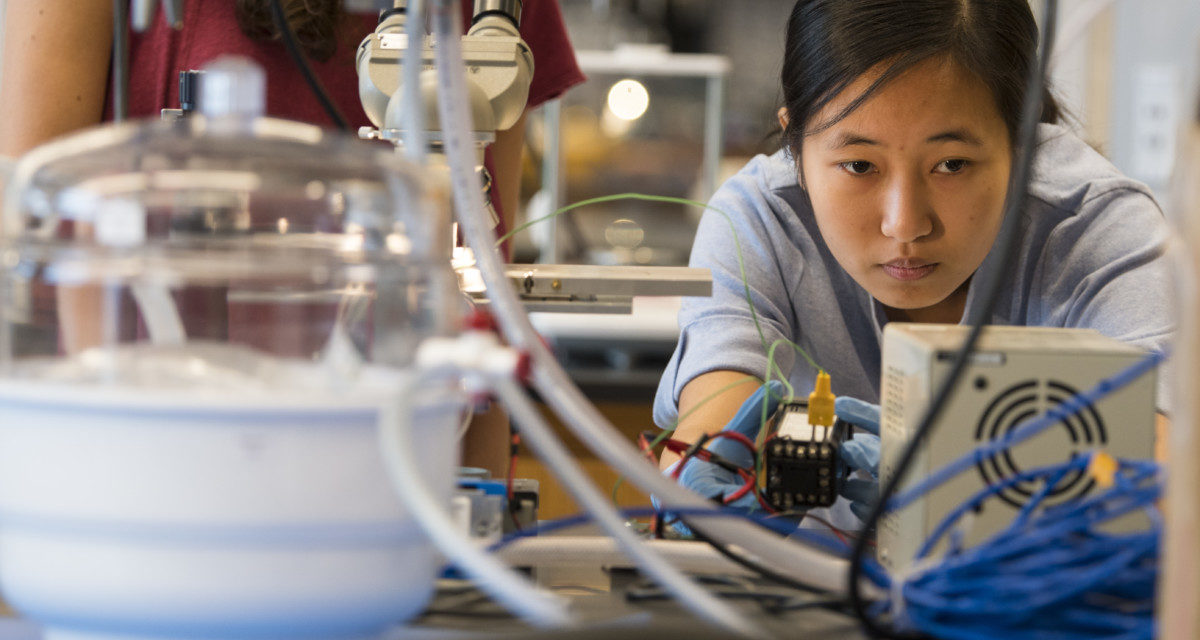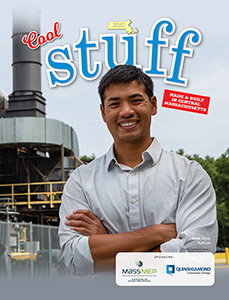Connecticut colleges are expanding their STEM programs, as the manufacturing industry pushes for more workers with advanced technology educations
In a time where innovation and development is crucial, collegiate STEM education continues to be an area of study that is important and necessary.
As the coronavirus remains a force to be reckoned with, Connecticut universities continue to find ways to enhance science, technology, engineering, and mathematics education.
In order to prepare the future STEM workforce, institutions such as UConn, Goodwin University, and Fairfield University increase education through new developments, programs, and facilities.
New STEM facilities
UConn Provost Carl Lejuez, who also serves as the executive vice president of academic affairs, said the institution is now constructing a Northwest Science Quad to help tie the university’s research expansion, academic vision, and culture of innovation for STEM students.
“We are starting construction on this complex with the Science 1 building,” Lejuez said. “If all remains on schedule, the research labs and other facilities inside the building would be ready to use by fall 2022.
UConn is no stranger to constructing new facilities, as the school constructed a new engineering and science building back in 2018, as well as the expansion of various other academic buildings. Lejuez sees the state’s investment in these programs as an opportunity for innovation within STEM.
“It’s a big step forward in the state’s investment in UConn as an engine for innovation and economic development in Connecticut,” Lejuez said, “and enhances the resources available to our faculty, staff, and students to advance Connecticut as a leading hub of STEM innovation.”
Dr. Clifford Thermer, dean of Goodwin University’s school of business, technology, and advanced manufacturing, said the expansion of STEM facilities comes from increased demand.
“We’ve expanded our CNC lab four times here in the last five years because of the demand,” Thermer said. “We just expanded the welding lab … We are adding, and we are just starting off a new mechatronics and automations program.”
Thermer said these new programs have been in development for the past two years and put on pause because of the coronavirus. He describes mechatronics as the integration of mechanical and electrical.
“We are working pretty closely with the German-American Chamber of Commerce here in Connecticut,” Thermer said. “To be able to refine that for a number of companies that need that skill set.”
STEM outreach for K-12
A common theme amongst universities increasing STEM education is through introducing it to younger students. Thermer details Goodwin’s high school STEM outreach programs.
“We’re able to start offering our students as early as 9th grade an exposure to manufacturing and the STEM disciplines,” Thermer said. “They can start earning college credits towards the certificates while they’re in highschool.”
Goodwin University owns and operates Connecticut River Academy, in East Hartford, and has an early college advanced manufacturing program run by the high school with partner school districts. Thermer said this allows for outreach amongst younger students interested in STEM fields.
“We are going from Pre-K all the way up through college right now,” Thermer said. “Our high school has both a manufacturing theme and an environmental sciences theme, and our students have the option of learning machining, and the manufacturing trade, as early as ninth grade.”
Fairfield University has made efforts to provide experiences and opportunities for students, said Dean Dr. Andres Caranno’s team at the School of Engineering.
According to the office of the dean, a free and full-day intro to engineering at the Norwalk Maritime Aquarium is an event, where middle and high school students attended interactive workshops led by Fairfield University engineering students.
“These efforts establish pathways for young minds, especially young women, to be excited about the possibilities in STEM fields and see themselves pursuing them,” Caranno’s team said in an email.
Fairfield University’s School of Engineering has also held a TEDx event in which a past engineering student has been featured, and throughout the years various other STEM centered events and workshops have been held.
“The student clubs in the School of Engineering also host many STEM-related events during National Engineers Week in February every year ” the office of the dean said. “As well as two on-site workshops for Girl Scouts in the Fall and Spring semester,”
Embracing neurodiverse students
UConn Engineering is developing an inclusive learning environment for neurodiverse students with the help of a $2-million grant from the National Science Foundation’s Revolutionizing Engineering Departments program.
“According to the statistics, only 3% of college students with ADHD study engineering,” Lejuez said. “And while 34% of college students on the autism spectrum were enrolled in a STEM-related field, only 5% were enrolled in engineering programs.”
Lejuez said these students are being left behind and schools are not working on ways to figure out how to help them find success. UConn wants to change that.
“Our program will be working over the next several years to build curriculums that leave no student behind,” Lejuez said, “offer support systems for these students, and eventually build a model that can be replicated across the country.”
What job outlook should STEM Graduates expect?
Within the age of the coronavirus pandemic, the job outlook for graduates is fairly different this year, but what can STEM graduates expect?
Lejuez sees opportunity for STEM graduates with crucial and important roles during the pandemic.
“For some employers, this has meant they have fewer career openings,” Lejuez said. “But for many other employers, this presents opportunities, as STEM fields are working on many of the solutions we need right now. We take UConn’s role in workforce development and economic growth seriously.”
Thermer also sees a bright outlook for STEM students even within the unique circumstances the pandemic presents.
“I would say students that are learning manufacturing, that are learning programming, that are learning welding, they have jobs, our students aren’t having a problem finding employers,” Thermer said. “So that’s a good thing.”
The reasoning behind this is because these careers are always needed, and employers want to get back to producing, as well as getting back to the economy before the pandemic, he said.
“They still gotta make a lot of parts,” Thermer said. “And the supply chain, those thousands of small manufacturing firms, they’re making a lot of parts for them, so they need a lot of workers, and they’re all doing what they can to hold onto these workers, and upscale them.”
The office of the dean of the School of Engineering at Fairfield University gave emphasis on other reasons why STEM careers are needed.
“What excites our new graduates is the fact that their skills are needed to solve some of the
world’s grand engineering challenges,” the office of the dean said. “These include providing access to clean water, developing carbon sequestration methods, discovering new clean sources of energy, engineering better medicines, securing cyberspace, and improving urban infrastructure.”
Fairfield University engineering graduates are beginning careers in healthcare device manufacturing, aerospace engineering, government, construction, research and development, enterprise software, and consulting.
Goals for the future of STEM education
With already various plans and innovative strategies in place to increase STEM education, these universities continue to set goals for the future.
Fairfield Engineering is looking toward expanding its courses, and enhancing its programs, as well as broadening the reach and real world relevance of their STEM offerings.
Fairfield University has also introduced two new master’s degrees programs in cybersecurity and data science.
“Students don’t just study in the classroom,” the office of the dean said. “They build Baja racing cars, drones, robots, and 3D printed medical prosthetics. We are also in the process of setting up a facility which will become the Innovation Studio and will be run and managed by STEM students. In this facility, equipment such as 3D printers, laser cutters, etc. will be available to support student creativity across campus.”
Other goals reiterated between Goodwin University and UConn relate toward the continuation of providing skilled graduates to the workforce.
“STEM fields play a large role in driving research expenditures,” Lejuez said. “Then, if you look at the hands-on experiences that are central to STEM education. We are proud of our role in driving the state’s economy, through educating a highly skilled workforce, as well as our opportunities for partnership and research with industries in the state.”
Thermer sees colleges and universities increasingly working together to fill STEM fields, putting emphasis on educating future STEM students.
“We have to work with those companies,” Thermer said. “To provide them the workforce they need, so we need to be doing more than that, and we need to keep our fingers on the pulse of where’s manufacturing going, where’s industry 4.0 going, what is the integration of computers, and machining and all of this, and how to do it better, faster, for less will always be the thing that keeps us competitive.”
“We’ve seen that happening over the last five years like never before, and it’s such a good thing to be happening,” he said. “At the end of the day, it’s Team Connecticut. We are all in this together.”



